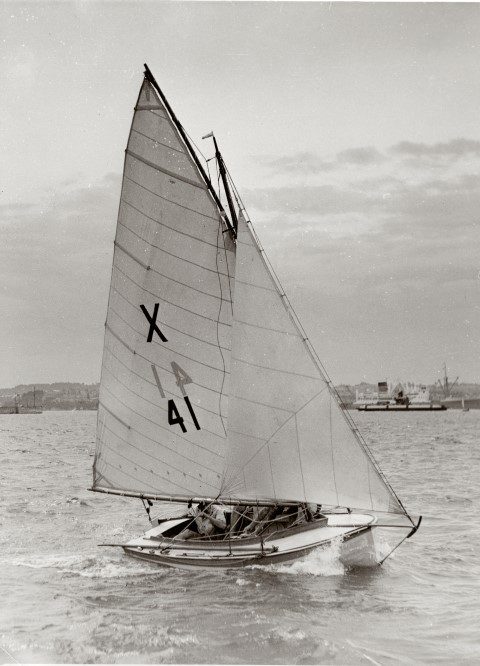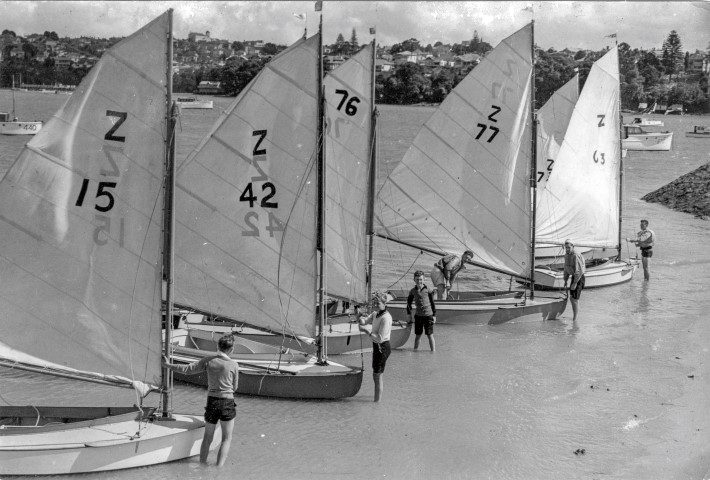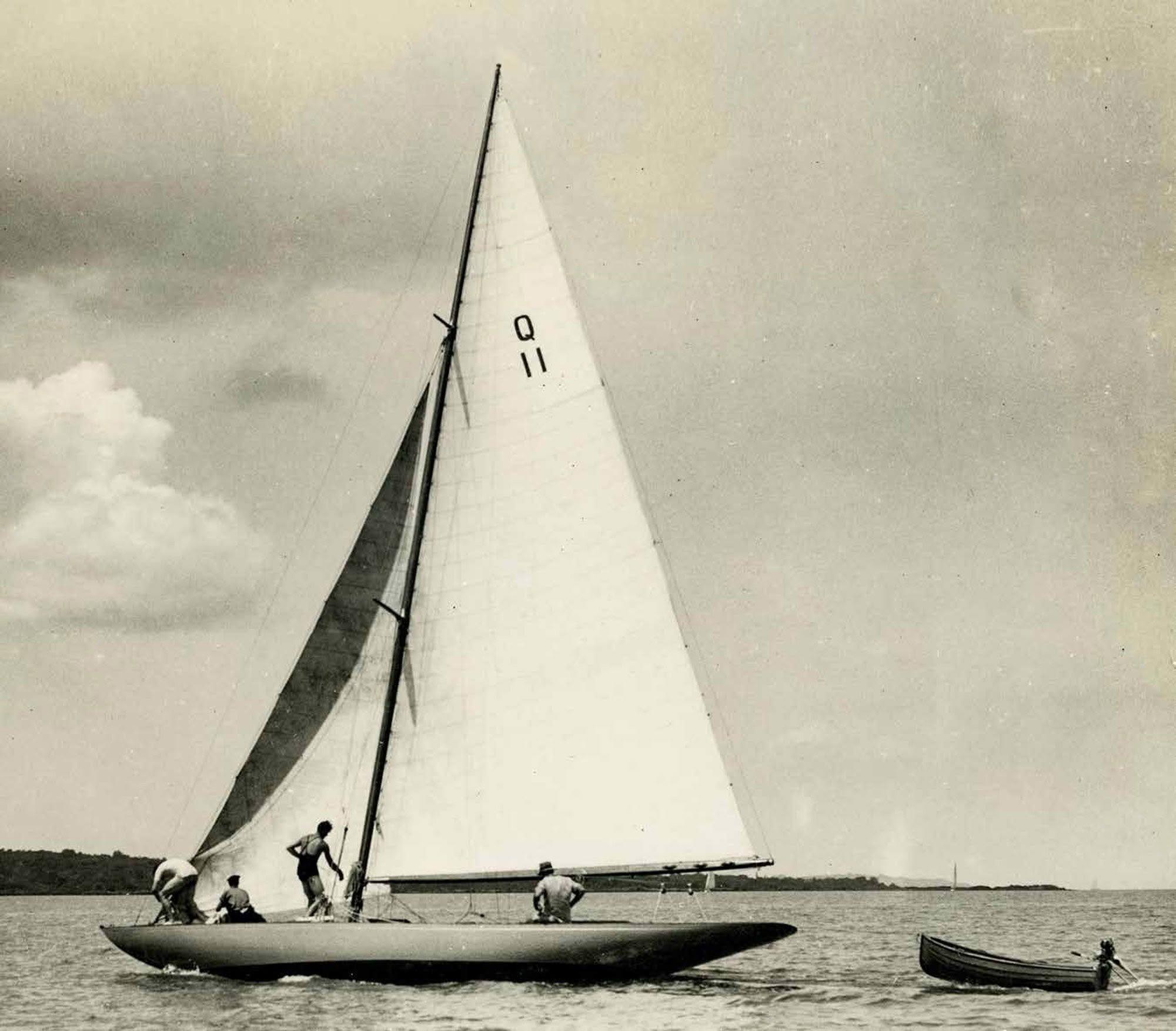

Those three classes were the Parnell Sailing Club 18ft 6in patikis of 1898, the Thorndon Dinghy Sailing Club 10-footers of 1903 and the Waitemata Dinghy Sailing Club 14-footers of 1907. They were a departure, too, from the ‘anything-goes-open sailing boat’ types that preceded them.
I also introduced the Jellicoe or Sanders Cup class of 14-footers (X Class to Aucklanders) which Gladwyn Bailey designed in 1916 for W.A. (‘Wilkie’) Wilkinson, the publisher of the New Zealand Yachtsman magazine. From 1920 this became a mushroom class and one of the most potent influences on the spread of the sport of yachting throughout New Zealand.

THE X CLASS
After war broke out with Germany in August 1914 Wilkie could see the sport had to be kept alive during the war and was determined to not only promote a new dinghy class for youth but also to ensure that it got the rules and infrastructure that would prevent its collapse like the three preceding classes.
Baileys built the prototype and launched her in January 1917. They named her Desert Gold after a famous racehorse of the time. Time stood still, however, until hostilities ceased and the Spanish flu epidemic was over. The euphoria of the post-war years was heightened when the popular new Governor-General, Lord Jellicoe, hero of the Battle of Jutland, arrived in the country. Jellicoe expressed great interest in the new 14-footer. Baileys built him Iron Duke to race.

Walker & Hall donated a magnificent trophy for annual provincial competition, the Sanders Cup, in honour of Lt. Cdr Sanders, the Kiwi hero of the Q ship Prize. There was now a potent mix of the Cup and the Vice-Regal involvement in racing which set the New Zealand yachting scene on fire. It guaranteed that the class spread the gospel of dinghy sailing to every port, lake and river of the country.
Initially the Royal New Zealand Yacht Squadron sponsored the class as a youth trainer, but this high intention failed because, under the glare of publicity and the pressure of high-level competition from the provinces vying for the Sanders Cup, the class administrators did not formulate nor did they impose adequate class restrictions. Professionalism in both building and crewing crept in and costs escalated so that the class was no longer just a youth trainer.
In 1923 the radical Bailey-designed Rona for Jack Gifford set the class on its ear and eventually became the class benchmark, with new rules massively tightened around this Rona-type 14. Despite decades of further political controversy, with classic divisions between Auckland and everyone else in the country, the class flourished as a top-drawer racer. But, by the 1950s the design had become dated.
In 1955 Sea Spray magazine conducted a design competition for a modern replacement in modern materials. The competition produced three excellent designs, one from Graham Mander, one from Hal Wagstaff and one from Laurie Davidson.
Mander’s design, intended for moulded veneer construction, was the winner but it was eventually produced in fibreglass. The mixture was flawed. Nobody really liked it, and the class died.
THE TAURANGA OR P CLASS – 1919
The Tauranga seven-footer has played an enormous role in training New Zealand boys and girls in the basics of sailing since civil engineer Harry Highet designed and built the prototype in Whangarei in November 1919.
The Highet family had been pioneers of centreboard 14-footers in Wellington but, now that he was back from the war with a Military Medal, a wife and a growing family, and because he had very little money for materials and a tiny Public Works Department house, Harry halved that dimension.

He built himself a unique square-bilge, catrigged seven-foot midget boat with a minute cockpit. The rest of the hull was buoyancy compartments, because he could not swim. It was an astonishing, unprecedented, almost comic, concept at the time.
Six-footer Harry demonstrated the little yacht, Mascot, at the Onerahi Regatta on New Year’s Day 1920. He stood up on the gunwale and, as expected, instantly capsized. Harry then gave a mighty heave, turned the craft upright, hove himself in, and sailed away within 20 seconds of the capsize.
This demonstration led to Harry building five more boats for local lads who went off around Whangarei Harbour racing and cruising. They camped on the beaches by pulling the boats up and putting them on their sides to form a shelter. Their masts and booms supported their sails to become a neat communal tent.
The energetic Tauranga Yacht & Power Boat Club was formed in 1920. In 1923 the equally energetic Harry Highet, on Government transfer, arrived with his midget yacht into a fertile demonstrated the little yacht, Mascot, at the Onerahi Regatta on New Year’s Day 1920. He stood up on the gunwale and, as expected, instantly capsized. Harry then gave a mighty heave, turned the craft upright, hove himself in, and sailed away within 20 seconds of the capsize.
This demonstration led to Harry building five more boats for local lads who went off around Whangarei Harbour racing and cruising. They camped on the beaches by pulling the boats up and putting them on their sides to form a shelter. Their masts and booms supported their sails to become a neat communal tent.
The energetic Tauranga Yacht & Power Boat Club was formed in 1920. In 1923 the equally energetic Harry Highet, on Government transfer, arrived with his midget yacht into a fertile environment. By October 1924 11 ‘Taurangas’ were racing with the club. A year later there were 16 and the class had spread to Wellington where Joe Jukes built 10 at £10 each, all complete.
In 1941 the Ponsonby Cruising Club established the class in Auckland to train youngsters to sail while normal club activities were suspended during the war. Ponsonby was planning for a strong postwar cadre of skilled young people. Tauranga seven-footers in other centres tended to use ‘T’ for ‘Tauranga’ on their sails, but that letter was already in use by the strong Auckland class of round-bilge unrestricted 14-footers.
The class letter ‘P’ was not in use in Auckland and ‘P’ echoed the ‘P’ of the Ponsonby Rugby League Club’s ‘Ponies’, the junior footballers from whom Ponsonby Cruising Club drew many of the boys that it wanted to train to sail. By 1952 there were over 140 boats registered in Auckland alone.

Since then the P Class has been part of the mainstream of New Zealand yachting. The all-comers’ Tauranga Cup, first awarded in Wellington in 1940, and the inter-provincial Tanner Cup in 1945, are still well contested. Thousands of Kiwi yachtsmen and yachtswomen have learned to sail in P Class including heavyweights of national and world yachting like Sir Peter Blake and Sir Russell Coutts.
THE TAKAPUNA OR Z CLASS – 1921
The Takapuna Boating Club was formed in 1920 to cater for small craft sailing off Takapuna Beach and subsequently in Shoal Bay. The club commissioned Sulphur Beach boatbuilder Bob Brown to design and build a basic, cheap two-man youth trainer.
The result was a minimalist gunter cat-rigged square-bilge ‘flattie’ with a small flat-cut spinnaker, 12ft 6ins LOA with a beam of 5ft, with every scantling and dimension of hull, rig and sails rigidly controlled. The philosophy behind the design was that the boats should be so identical that the twoman crews could ballot for them and they would all perform exactly the same.

This Takapuna, or Zeddie ‘monotype’ had design flaws, but those flaws made it an ideal, challenging trainer. It had so little buoyancy forward that spinnaker work was tricky, especially in heavy conditions when it had a tendency to ‘pig-root’, to bury its bow, despite its generous forward splashboards, but it planed readily on a reach and was great fun.
Once again, Walker & Hall presented a significant trophy, the Cornwell Cup, for competition between under-19s from individual ports. Like the Sanders Cup, it again honoured a war hero, 16-year old Seaman’s Boy Jack Cornwell who kept his gun firing on HMS Chester during the Battle of Jutland in May 1916 when the rest of his gun crew had been killed. Jack was posthumously awarded the Victoria Cross.
This cup too, gave the ‘Zeddies’ an extra national dimension like the Sanders Cup gave the X Class, which ensured that they spread throughout New Zealand and produced a who’s who of future top yachtsmen.

In 1960 John Spencer rejigged construction in plywood, but it was too late to save the class. Nowadays Zeddies survive only in penny numbers in places like Whangateau and Hobsonville but are well beloved by their owners.
I’ll return in a few months to continue the story of our national centreboard classes.




